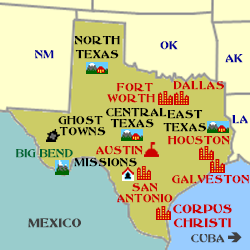In 1519 explorer Alonzo Alvarez de Pineda discovered a lush semi-tropical bay on what is now the southern coast of Texas. It was Roman Catholic Feast Day of Corpus Christi (Body of Christ)so that was the name that he gave to the bay. Little more is recorded until 1839 when Colonel Henry Lawrence Kinney founded a trading post on the shore of the bay. The Texas Republic was only three years old and the land was still in dispute with Mexico but little happened until after Texas became part of the USA. In 1845 US troops under General Zachary Taylor arrived at Kinney’s Trading Post in readiness for war with Mexico. They stayed until the following spring when they marched south to enforce a border along the Rio Grande. In 1847 the town was renamed Corpus Christi after the bay on which it stood. It became an incorporated city in 1852 with an elected mayor and city council. During the Civil War the city voted to secede from the Union, but there was a sizeable minority who supported the Union. Union warships bombarded Corpus Christi in August 1862 causing considerable damage and afterwards Confederate forces plundered the property of Union supporters to take revenge. With Corpus Christi Bay sheltered from the Gulf of Mexico by barrier islands, the city was an ideal location for a deep water port. This was first mooted in the 1840s but it was not until 1925 that the Port of Corpus Christi opened for business, handling mainly oil and agricultural products.
Gugenheim House, Heritage Park
Twelve historical Corpus Christi homes, the oldest dating back to 1851, have been brought together and restored in Heritage Park. Simon Gugenhein arrived in Corpus Christi in 1882 with just forty dollars in his pocket. In 1891 he co-founded the Gugenheim & Cohn Drygoods Company and during the 1896 recession he acquired a great deal of property. He later invested in the Petroleum Industry. This house was built for Gugenheim and his wife in 1905. It was built in the late Victorian style complete with classic gingerbread details. It was one of few Victorian homes that survived the hurricane of 1919, one of the strongest storms of the 20th century with winds reaching 177 kph (110 mph) and wave heights of 5 metres (16 feet). This house was moved to Heritage Park in 1977. Its front rooms have been furnished in the style of the 1900s. Click Tab 2 to see the Lawrence House dating from 1893 which was moved to Heritage Park in 1999
Art Museum of South Texas,
We had not scheduled enough time when we visited Corpus Christi, so we were unable to experience the interior of the Art Museum of South Texas. The building, standing on the shore of Corpus Christi Bay, is itself a work of art. Designed by New York architects Phillip Johnson and John Burgee, the museum opened in 1972. The part of the building with pyramids on its roof is and extension opened in 2006. The museum has a small permanent collection but also specialises in hosting travelling exhibitions.
USS Lexington
The USS Lexington is a World War II Essex Class Aircraft Carrier. She was originally to be named USS Cabot but just before she was completed in 1943 the USS Lexington was sunk in the Coral Sea, so the name of the new carrier was changed from Cabot to Lexington. The new USS Lexington was involved in nearly every major wartime operation in the Pacific. After the war she was decommissioned but in the 1955 she was modernised and reactivated. She saw service in the Atlantic, Mediterranean and Pacific until in 1962 she became a training carrier based out of Pensacola, Florida. She remained in service right through to 1991 when she was decommissioned and donated for use as a museum ship in Corpus Christi. The USS Lexington museum opened in October 1992. In addition to exploring the ship, visitors are able to view 20 historical aircraft on loan from the National Museum of Naval Aviation.
Corpus Christi
Corpus Christi from Oleander Point, Cole Park
The curving shore of Corpus Christi Bay gives a superb view of the city from Cole Park. The 1860 US census showed that Corpus Christi then had a population of 175. Nowadays the city (excluding the surrounding metropolitan area) has a population well over 300,000 making it the eighth largest city in Texas by population. Oil and petrochemicals is the largest industry, but with its bayside location and humid subtropical climate Corpus Christi is also a major tourist destination. This tourist-friendly location comes at a price, in the 20th century Corpus Christi was affected by at least seven major hurricanes or tropical storms.
Click on Minimap to navigate
Home > US States > The Southwest > Texas >


To move forwards or backwards through the Texas trail click the arrows above, or select your next destination on the Minimap.
DLU161211






© Mike Elsden 1981 - 2025
The contents of this page may not be reproduced in full or in part without permission